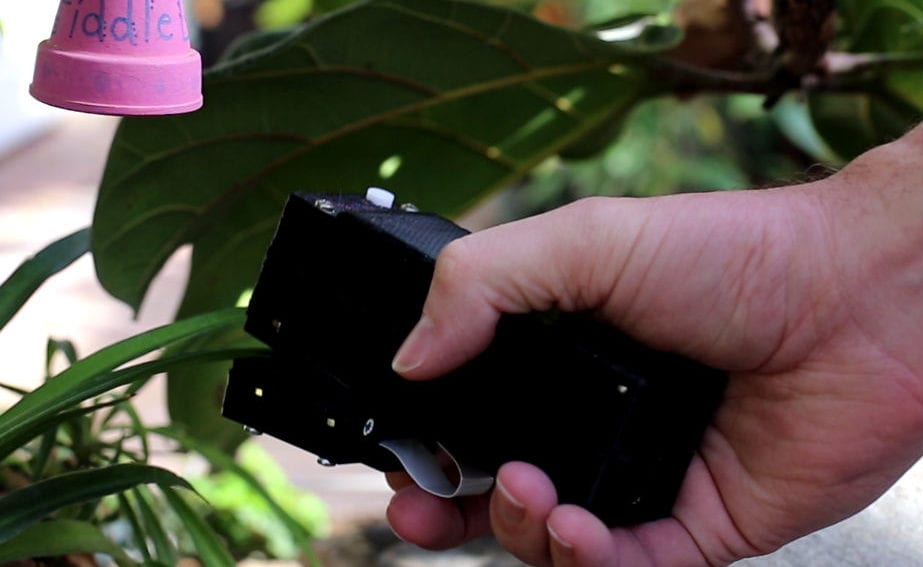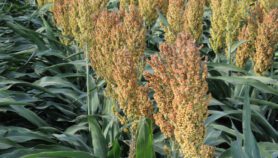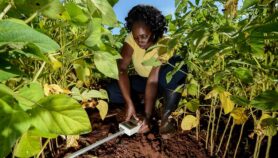By: Inga Vesper
Send to a friend
The details you provide on this page will not be used to send unsolicited email, and will not be sold to a 3rd party. See privacy policy.
PhotosynQ, a project based at the University of Michigan in the United States, aims to help plant scientists around the world gather data through a cheap hand-held device called MultispeQ for scanning plant material.
By connecting the device to a smartphone, researchers can use it to collect information about how efficiently a plant photosynthesises, for example, as well as data on the soil it is growing in. Data is automatically updated from the phone to a cloud server. PhotosynQ’s four founders run an open access website and smartphone app through which researchers can remotely monitor, compare and analyse this information. They hope it will give researchers, particularly those in developing countries, access to a wider range of information on which to base decisions about breeding better plant varieties.
SciDev.Net spoke to Greg Austic, a games designer and cofounder of PhotosynQ, about the project’s growth and how it hopes to democratise science.

How did the idea for PhotosynQ come about?
We [the founders] went to a conference in Japan, where we met a plant science professor from Africa. Our main founder David Kramer had developed a benchtop plant research facility for about US$20,000. The African partner said he wanted to have one of those, because it would really advance their science. But he said the costs for this equipment are “like the cost of my entire department”. And we thought: “This is stupid. He should really be able to use these things too.” Kramer got it in his head that he could make a hand-held version of his device. So that’s when it took off.
You call PhotosynQ the Facebook of plant science. Why is that?
We wanted to create a platform where anyone can create and analyse plant science information. So it is like Facebook: it allows people to create content and discuss pictures. We wanted to democratise the collection of data about plants, so that anyone in the world can go and collect interesting data. But much more importantly, we wanted to democratise the ability to ask an interesting question. The way traditional science works right now is that a professor can ask a question, go get a grant and then answer it. But I want science to work so that some 15-year-old in China with an interesting question can ask it, collect data as part of this project and then talk about it with other scientists, analyse it and come to a conclusion.
So far, participants have collected about 20,000 readings. Where are the researchers involved in these projects?
We have a lot of collaborators in Malawi, Zambia and Argentina. We also have devices operating in Mexico and in the United States. We have four devices in India and even one on the Falklands Islands [Islas Malvinas]. We’ve only shipped around 20 devices so far, but we are getting data from all over the world. The goal is to create a big community of people who are capable and knowledgeable, so that someone can ask a big global question and get answers, because there are people all over the world who can respond.
Do you have an example?
There is a lecturer at the University of Zambia, Kelvin Kamfwa, who is trying to create a drought-tolerant bean. Now, the big companies don’t care about Zambian beans, because they cannot make money there. And the Zambian government does not have that much money to fund science. Academics don’t get paid that much and they don’t have money for equipment, so he’s got to do it the old-fashioned way by crossing varieties, planting them, seeing which ones perform best, repeating this process, and it goes on and on and on. But with this device he will get information on soil activity, light absorption and photosynthesis, so he will be able to speed up this breeding by selecting plants more accurately and earlier than he could without it.
And where does the collaboration come in?
We have tools to help this scientist analyse the data. The scientist in my example can then connect with someone in, say, North Dakota, United States, where we have a lot of common beans, and they can have a discussion about what the data look like and the actual results, which could give the breeder new ideas for plant selection. Other people might trial some findings in North Dakota — and there you have collaboration.
The devices cost only US$100. How many devices do you think you can shift?
Honestly, we are just guessing. Our plan is to get a couple of hundred — maximum 400 — devices out this year. Then, at the start of next year we will have a new version, the production of which will be outsourced. We will make a few thousand, so I guess it is feasible to sell around 10,000. We do not actually want the biggest possible community, we want the most qualified possible. For example, if someone gets a device but doesn’t know what he’s doing and doesn’t take the time to collect good data, then there’s no point. No matter how fancy you make the device, you still have to think and engage in science. So I would rather have 200 people who are into this and do quality measurements than 100,000 who don’t care.
But how will you fund PhotosynQ a few years down the line? Can you keep the prices low?
We have been aware of that problem since we started. You cannot ship 10,000 units from a university, that’s not what a university is meant to do. We are really in it for the content, not the money, but when you are trying to run this kind of operation, it is probably easiest to run as a for-profit outfit. If the volumes of sales increase, that’s likely what we will do.
Q&As are edited for length and clarity.














